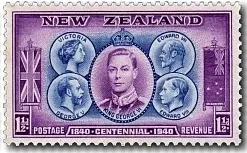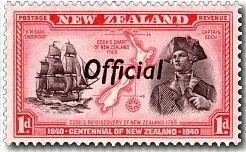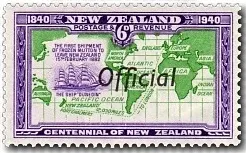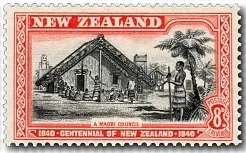As 1940 approached, New Zealand Government Officials were considering ways in which The Dominion could celebrate its first centenary. A great exhibition was planned in Wellington.
I remember my father telling us that as a boy most of his small country school travelled by train from their little community in Northland, all the way to Wellington. They slept in the classrooms of a local school while visiting the Great Centennial Exhibition and taking in the sights of the capital before returning to Northland on another special train.
Word spread ahead that this special train was passing through the various town and cities on the route and my mother told us that as a young girl she stood at the trackside in Avondale, Auckland, watching it go by. Little did she know that one day she would marry one of those 'country kids' hanging out the windows waving madly.
I remember their surprise that day as they realised that they could have looked at each other, all those years before they would eventually meet and get married when my father moved to Auckland.
Now back to the point of this blog post. One of the ways the authorities decided to celebrate this centenary was by issuing a special Centennial Pictorial Stamp Issue. This thirteen value stamp set, known as one of the better ones New Zealand has issued, depicted a wide range of subjects concerning the development of this young nation.
At the same time an eleven-piece "official" set was also released, to be followed in 1944 with a provisional overprint. All of these stamps are featured in this post. I have also thrown in a few printing errors and extra items of interest.
Each of these stamps tells an interesting story. It would be a shame to publish this post without including some of these stories here, so at the bottom, I have included each of the thirteen stamps again with more detailed notes on its design and subjects depicted. A number of these designs show Maori people of Maori history.
Airmail cover to the USA via New Caledonia, Reg. Auckland 19th July 1940.
1/- "Tane Mahuta" God of the Forest.
This is known as a plate strip since it shows both the plate number and printer.

Abel Tasman - 2d
Abel Tasman, a Dutch captain employed by the Dutch East India Company to search for new and profitable lands for trade, first discovered New Zealand on 13 December 1642. The coastline he approached was an open coast where he was unable to land, due to the rough surf, so he turned north looking for a more favourable location. He found what we now know as Golden Bay and landed with some of his crew. A skirmish with the local Maoris cost him some of his men and so he never landed again. Abel Tasman named this new land after the Netherlands province, Zeeland.
The stamp shows Abel Tasman on the left, his ship the Heemskercq in the centre and the map of the part of New Zealand he explored on the right. The large bay on the map actually turned out to be Cooks Strait between the North and South Islands of New Zealand.

The Signing of the Treaty of Waitangi - 2½d
On 5 February 1840, a mass meeting was held on the north bank of the Waitangi River mouth, where the aims and purpose of this new Treaty explained to the Maori. The next day the chiefs signified their willingness to accept the conditions, and 46 paramount chiefs either signed the Treaty or affixed their mark. The Treaty was then taken around New Zealand so other chiefs could also sign. The original signing in Waitangi is depicted on the stamp.
The Treaty of Waitangi was an agreement between the British representing Queen Victoria and the Maoris of New Zealand. It is a basis of harmony between the people of New Zealand today. It may surprise many people to learn that the Treaty is no longer a legally binding document in New Zealand but it is still considered by the Government when settling the land claims made by many different Maori tribes.
I remember my father telling us that as a boy most of his small country school travelled by train from their little community in Northland, all the way to Wellington. They slept in the classrooms of a local school while visiting the Great Centennial Exhibition and taking in the sights of the capital before returning to Northland on another special train.
Word spread ahead that this special train was passing through the various town and cities on the route and my mother told us that as a young girl she stood at the trackside in Avondale, Auckland, watching it go by. Little did she know that one day she would marry one of those 'country kids' hanging out the windows waving madly.
I remember their surprise that day as they realised that they could have looked at each other, all those years before they would eventually meet and get married when my father moved to Auckland.
Now back to the point of this blog post. One of the ways the authorities decided to celebrate this centenary was by issuing a special Centennial Pictorial Stamp Issue. This thirteen value stamp set, known as one of the better ones New Zealand has issued, depicted a wide range of subjects concerning the development of this young nation.
At the same time an eleven-piece "official" set was also released, to be followed in 1944 with a provisional overprint. All of these stamps are featured in this post. I have also thrown in a few printing errors and extra items of interest.
Each of these stamps tells an interesting story. It would be a shame to publish this post without including some of these stories here, so at the bottom, I have included each of the thirteen stamps again with more detailed notes on its design and subjects depicted. A number of these designs show Maori people of Maori history.
For an index to all our posts concerning New Zealand Maori.
1940 Centennials.
The landing of First Maori - ½d. Captain Cook and the Endeavour - 1d.
British Sovereigns - 1½d Abel Tasman - 2d
Treaty of Waitangi - 2½d Settlers at Petone Beach - 3d
Transport - Land, Sea and Air - 4d Hoisting of Flag at Akaroa - 5d
First shipment of frozen mutton - 6d Gold Mining dredge - 9d
Maori Council - 7d Maori Council (issued 8 March 1940) - 8d
A Giant Kauri - "Tane Mahuta"
God of the Forest - 1/-.
1940 Centennial Special Covers.
A First Day Cover 2nd January 1940
A Second Day Cover of the 1940 Centennial Issue.
I have heard of First Day Covers before but this is the first time I have come across
a Second Day Cover. See the date cancel says 3rd January 1940 It appears this must have been a mistake of some kind and the cover was intended to have been cancelled on the first day of issue. But for me, a Second Day Cover is far more interesting.
A cover from the 1940 Centennial Exhibition in Wellington, with a cancellation from the Exhibition Post Office, a special office set up for the exhibition. The blue handstamp states it was posted at the top of the Centennial Tower.
Airmail cover to the USA via New Caledonia, Reg. Auckland 19th July 1940.
1/- "Tane Mahuta" God of the Forest.
This is known as a plate strip since it shows both the plate number and printer.
Printing Errors.
This is the 1½d British Sovereigns. The printer has applied too much ink
which has off-set onto the back of the stamp above.
A block of 5d Hoisting of Flag at Akaroa where the inside blue colour has moved to the right. On the left side of each stamp, you can see a white
gap against the frame, while on the right the blue overlaps the frame. There is another example of this side shift in the stamp below. The black line across this stamp from top to bottom is a postmark, not a printing error.
Two blocks of the 2½d Treaty of Waitangi. On the lift is a normal example while in
the right block all four stamps show a downward shift of the green.
1940 Centennial Officials.
Below are the stamps known as the 'Officials' where 11 of the 1940 Centennials were overprinted with the word "Official" for use by Government Departments.
To view all the 'Official stamps produced by New Zealand visit An Official Post.
The landing of First Maori - ½d. Captain Cook and the Endeavour - 1d.
British Sovereigns - 1½d Abel Tasman - 2d
Treaty of Waitangi - 2½d Settlers at Petone Beach - 3d
Transport - Land, Sea and Air - 4d. The first shipment of frozen mutton - 6d.
Maori Council - 8d. Gold Mining dredge - 9d
A Giant Kauri - "Tane Mahuta"
God of the Forest - 1/-.
Official FF Printing Variety.
Apart from the 5d, 7d and 10d values, the stamps were overpriced, Official. With the ½d, 1d, 2d, 3d, 4d, 6d and 8d values, a variety occurs at row 1/10 in which the ff is joined where normally there should be a gap between. This variety was quickly noticed and became a collector item while still available from the Post Office. Finally, on 12th March 1941, the Philatelic Bulletin stated: - Stocks of the double "f" variety on the 1d., 2d., 4d., and 6d., denominations of the Centennial Official stamps are exhausted.
FF Joined - Variety. FF Gap - Normal.
Three examples of the FF Variety paired with a normal. When compared with a normal example the spacing between the "f"s is quite noticeable.
Two further examples of the joined FF which seems to have appeared on many of this issue.
Official Covers.
A cover showing the full set of 1940 Centennial Officials.
Two covers with "official" stamps form the 1940 Centennials.
Not all "Official" letters carried postage stamps. On the cover below from this same period,
the postage was recorded with just a hand-stamp.
1944 Centennial Provisional.
British Sovereigns
10d. Overprint.
10d. Overprint.
Due to a change in postal rates the 1½d Sovereigns was overprinted with the word "Tenpence" while the corner values were blacked out.
Below is a First Day Cover of the overprint.
The Designs in More Detail.
Each stamp in the 1940 Centennial Issue has an interesting story to tell so I decided to include the entire set of thirteen stamps with more details on their design and subjects.
For an index to all our posts on New Zealand Maori.
The landing of Maori in New Zealand - ½d
At school, I was taught that the Maoris arrived in a fleet of canoes and then dispersed to settle in various parts of New Zealand. This has since been proved as a myth with the Maoris arriving over a period beginning around 1000AD. It is also believed that some canoes returned to the Pacific islands, for a while keeping in contact people who stayed behind. For some reason, the Maoris stopped building double-hulled, ocean-going vessels in favour of large single-hulled vessels. The people living in New Zealand had lost contact with other parts of the Pacific, so by the time the Europeans arrived their old homelands were just oral traditions.
The scene depicted on the stamp is an original conception by an artist of the arrival of one of the canoes The Maoris have been pictured here as arriving in a state of physical exhaustion, the inevitable consequence, despite their magnificent seafaring skills, of weeks spent in open canoes.
Captain Cook and the Endeavour - 1d.
See our collection of Capt. Cook stamps - Captain Cook Stamps of New Zealand.
Every child in New Zealand schools is taught that Abel Tasman discovered New Zealand in 1642, but after only briefly exploring parts of the west coast he sailed away again and the country lay unexplored until 1769 when Captain James Cook arrived.
Cook's first voyage was based on the idea that the major landmasses of the northern hemisphere must be balanced with a major landmass in the southern hemisphere. He explored around New Zealand in the hope it was connected to this Southern Continent but as we know today this hidden continent never existed.
The 1d. stamp shows Captain James Cook on the right-hand side, with his ship the Endeavour on the left. In the middle is one of the first maps he made of New Zealand. This map has proven to be surprisingly accurate in most of its details. Noticeable errors are making Stewart Island part of the mainland and Banks Peninsular an island.
British Sovereigns of New Zealand - 1½d
This stamp showing King George VI first appeared in the 1940 Centennials as the 1 1/2d then it was overprinted with the word 'Official' for use by Government Departments. Later it was overprinted with the word 'Tenpence' and re-issued in 1944.
The design is very interesting in that it also shows four other royal heads of state as well. In the top left corner is Queen Victoria. In the top right side is her son King Edward VII. In the lower-left is Edward's son King George V. George V had two sons, King Edward VIII in the bottom right corner and of course King George VI in the centre. On the left is the flag of Britain and on the right the flag of New Zealand.
Happy Birthday! Penny Black! A post marking the history of postage stamps.

Abel Tasman - 2d
Abel Tasman, a Dutch captain employed by the Dutch East India Company to search for new and profitable lands for trade, first discovered New Zealand on 13 December 1642. The coastline he approached was an open coast where he was unable to land, due to the rough surf, so he turned north looking for a more favourable location. He found what we now know as Golden Bay and landed with some of his crew. A skirmish with the local Maoris cost him some of his men and so he never landed again. Abel Tasman named this new land after the Netherlands province, Zeeland.
The stamp shows Abel Tasman on the left, his ship the Heemskercq in the centre and the map of the part of New Zealand he explored on the right. The large bay on the map actually turned out to be Cooks Strait between the North and South Islands of New Zealand.

The Signing of the Treaty of Waitangi - 2½d
On 5 February 1840, a mass meeting was held on the north bank of the Waitangi River mouth, where the aims and purpose of this new Treaty explained to the Maori. The next day the chiefs signified their willingness to accept the conditions, and 46 paramount chiefs either signed the Treaty or affixed their mark. The Treaty was then taken around New Zealand so other chiefs could also sign. The original signing in Waitangi is depicted on the stamp.
The Treaty of Waitangi was an agreement between the British representing Queen Victoria and the Maoris of New Zealand. It is a basis of harmony between the people of New Zealand today. It may surprise many people to learn that the Treaty is no longer a legally binding document in New Zealand but it is still considered by the Government when settling the land claims made by many different Maori tribes.
Settlers disembarking at Petone Beach - 3d
In 1837 the New Zealand Association was formed in London with a purpose to buy land from the Maori and establish settlements of emigrants from England. The picture shows the settlers landing at Petone Beach in what was to become the city of Lower Hutt, across the harbour from our capital city Wellington.
The Progress of Transport - 4d
This is an interesting stamp in that it features several pictures in its design. The theme is the development of transport and its importance to open up New Zealand for future growth.
On the left is a bullock team pulling a load over an almost impassable road. Railways proved better at opening up inland areas and a steam-hauled passenger train can be seen on the right. In the centre, we can see New Zealand's connection to other international countries, first by ship and then later by aircraft.
Hoisting of Flag at Akaroa - 5d
In 1840 concern was growing over the French settlement at Akaroa on the Banks Peninsular of the South Island. It was thought that the French might use this settlement as a basis for an attempt at the annexation of the South Island from the rest of New Zealand. The British warship HMS Britomart was hastily dispatched from the Bay of Islands to perform a flag-raising at Akaroa to show the South Island as being under British Sovereignty.
The first shipment of frozen mutton to the United Kingdom - 6d
The ship on the stamp above is the Dunedin. She was outfitted with refrigeration equipment so she could transport frozen mutton and beef from New Zealand to England. The first voyage, in 1882, was not entirely successful with a small loss of product being discovered upon unloading but it proved it was possible to store and transport frozen meat.
This was a major advancement for this young colony as it allowed opening new markets for pastoral production. Today the export of lamb, beef and dairy products are still very important industries for New Zealand.
Maori Council - 7d. Maori Council - 8d.
The Maori meeting house is an important part of Maori culture and most important meetings take place either in or in front of the house as shown on these two stamps. The meeting house with the most important building in the village and so featured carvings inside and out telling the history and stories of the tribe.
With the outbreak of war postal rates changed and 7d stamps were found to be no longer required. Since 8d was used on parcels it was decided to re-issue the meeting house stamp with this new value.
The Post Office Philatelic Bulletin states:-
When the Centennial stamps were being prepared, the selected denominations were considered to be the most suitable to prepay the postage rates then in force, but on the 1st October last the rates were increased, and to meet the convenience of the general public, arrangements were made immediately for the printing of an 8d. value. The 8d. stamp, which is the same design and colours as the 7d. value will be placed on sale on the 8th March, and the 7d. denomination will be withdrawn from sale at the close of business on the 7th March.
Philatelic Bulletin No 1 (1940) 8th February 1940.
Gold Mining - 9d
Gold was first discovered in New Zealand in 1852 but it wasn't until 1861 that the first major gold rush took place in the Otago alluvial goldfields. Later gold was also discovered in Westland and the Coromandel of the North Island.
The stamps show how the gold was originally found by gold panning as depicted on the left while later dredges were used in large scale mining operations.
"Tane Mahuta" God of the Forest - 1/-.
This giant kauri tree is found in the Waipoua Forest Reserve in Northland. It is one of the largest trees in New Zealand and one of the easiest to view. The kauri tree is noted for the way it drops its lower branches as it matures to take on the appearance shown in the stamp above.
"Tane Mahuta", which means God of the Forest, is said to be over 2000 years old. Trees such as this have become hollow in their inside and over time will die by rotting from the inside out. Tane Mahuta is now showing signs of this with many dead branches in its crowning head.
I remember the first time I saw this tree. We had travelled in darkness to be there at dawn. Walking through the forest as the sun touched the treetops was an experience caped only by walking around a corner to see this giant before us.
The total numbers printed are given below with the numbers subsequently overprinted Official given in brackets. The 5d and 7d were not overprinted.
½d: 38,040,000 (1,082,760) 1d: 79,279,920 (3,452,880)
1½d: 11,552,000 (361,200) with 3,842,280 surcharged 10d
2d: 117,180,000 (6,960,360) 2½d: 2,280,000 (241,600)
3d: 8,760,000 (904,200) 4d: 3,840,000 (481,200)
5d: 3,280,000 6d: 6,480,000 (661,200)
7d: 1,140,000 with 591,608 sold before replaced by 8d
8d: 3,600,000 (240,840)
9d: 2,640,000 (241,200) 1/-: 3,978,360 (372,840)
10d: 3,824,280 1½d overprinted.
Technical information
Date of Issue:
| 2 January 1940 |
|---|---|
Designers:
| LC Mitchell, Wellington and J Berry, Wellington |
Printer:
| Bradbury Wilkinson, England |
Stamp Size:
| 1/2d, 1, 1 1/2d, 2d, 3d, 4d, 6d, 7d, 8d and 9d : 40mm x 24mm; 21/2d : 24mm x 28mm; 5d : 27mm x 24mm; 1s : 24mm x 40mm |
Sheet Size:
| 1/2d, 1d, 1 1/2d, 2d, 3d, 4d, 6d, 7d. 8d, 9d and 1/-: 120 stamps per sheet; 2 1/2d and 5d: 160 stamps per sheet |
Process:
| Recess printed - Intaglio |
Perforation Gauge:
| 2 1/2d : 14 x 13.5; 5d : 13.5 x 14; Other values : 13.5 |
Paper Type:
| Wiggins Teape unsurfaced, NZ and star watermark |
Some of the images in this post were used with permission from the illustrated catalogue of StampsNZ
You can visit their web site and On-line Catalogue at, http://stampsnz.com/



























































This is a good page.
ReplyDeleteI am not really into stamps but the way you display them make it interesting.
A agree with you. Each of these stamps has so much to say.
Kirsten.
We appreciate your engagement with our content. To ensure a respectful and constructive community, please take note of the following:
- No Spam, Please: We do not tolerate spammy or promotional comments. Any such comments will be promptly removed.
- Moderation in Place: All comments are moderated to maintain a positive and inclusive environment. Please be patient, as it may take a little time for your comment to appear.
- Sign In with Google: To comment, please sign in using your Google account. This helps us maintain the integrity of our community and allows for better interaction.